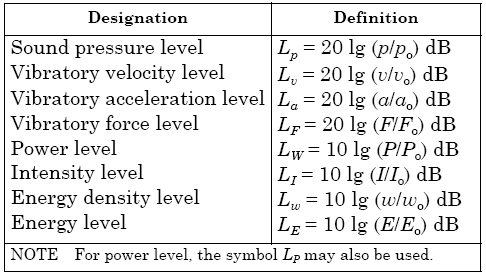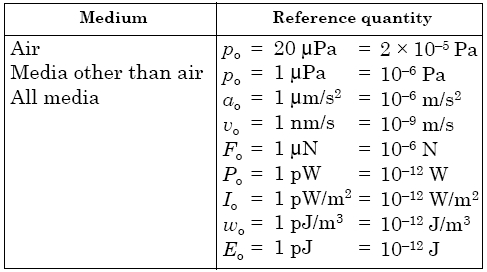8. Definitions
LEVELS and DECIBELS
- Decibel (dB)
A logarithmic ratio of two quantities - one-tenth of a Bel. The Bel is given as: log10(quantity1/quantity2) thus the decibel is given by:

- Sound Power Level (SWL, also LW, or sometimes PWL)
Sound power level - the logarithmic measure of sound power in comparison to a specified reference level of 10-12W
- Sound Intensity (I)
A measure of energy flowing through an area in a given time which is equivalent to power/area (watts/m2). Sound intensity is a vector quantity as the energy is passing in a particular direction.
- Sound Intensity Level (SIL or Li)
The logarithmic measure of the sound intensity relative to a reference intensity of 10-12W/m2. If I is the measured pressure then:

The SIL equation produces a sound intensity level value in decibels (dB)
- Sound Pressure (p)
The pressure deviation from the local ambient pressure caused by a sound wave. pressure is a measure of force (F) per unit area (S). So p=F/S. The SI unit for sound pressure is the Pascal (Pa), where 1Pa = 1N/m2
- Sound Pressure Level (SPL or Lp)
The logarithmic measure of the rms sound pressure relative to a reference pressure of 20μPa. If p is the measured pressure then:

The SPL equation produces a sound pressure level value in decibels (dB)
- Leq
The equivalent continuous sound pressure level. The level of a steady, continuous noise which has the same total energy as the real fluctuating noise measured over the same time period.
- LAeq
An A-weighted Leq - one of the best descriptors of human perception of sound pressure level.
- Lmax
Maximum sound pressure level measured over a measurement period
- Lmin
Minimum sound pressure level measured over a measurement period
- L1, L10, L50, L90 etc
Statistical parameters that describe the sound pressure level exceeded for a certain percentage of the measurement period. e.g. L10 is the level exceeded for 10% of the time, L90 is the level exceeded for 90% of the time. These can be modified by the appropriate weighting e.g. LA50 is the A-weighted level that is exceeded 50% of the time during the measurement period.
- Reference Quantities
These values are taken from BS EN 21683:1994 - Acoustics—Preferred reference quantities for acoustic levels. Table 1 shows the various acoustic levels expressed in decibels:

Table 2 shows the preferred reference quantities expressed in SI units:

References
- Haughton, P. (2002) Acoustics for Audiologists, Academic Press
- Watson, R. and Downey, O. (2008) The little Red Book of Acoustics. 2nd Ed. Blue Tree Acoustics
- BS EN 21683:1994 - Acoustics—Preferred reference quantities for acoustic levels.
- BS EN ISO 31-7:1992 - Acoustics-Quantities and Units